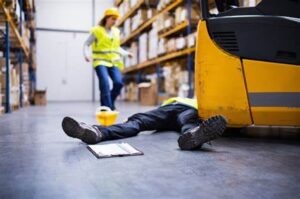 As we move into summer, June brings rising temperatures and increased outdoor activity, especially in industries such as construction, agriculture, logistics, and grounds maintenance. While the sun may boost morale, it also presents serious health and safety risks. Heat stress, dehydration, and UV exposure can all affect employee health and performance—and if not managed properly, can lead to serious incidents.
As we move into summer, June brings rising temperatures and increased outdoor activity, especially in industries such as construction, agriculture, logistics, and grounds maintenance. While the sun may boost morale, it also presents serious health and safety risks. Heat stress, dehydration, and UV exposure can all affect employee health and performance—and if not managed properly, can lead to serious incidents.
This month, we explore how employers can effectively manage hot weather risks to keep staff safe, comfortable, and productive.
Key Risks of Working in Hot Weather
Employer Responsibilities
Under the Health and Safety at Work etc. Act 1974, employers must provide a working environment that is safe and without risk to health—including managing environmental risks like heat.
The Management of Health and Safety at Work Regulations 1999 also require employers to assess risks (such as heat stress) and take appropriate control measures.
Practical Tips for Employers
Industry Example – Telford-Based Outdoor Workforces
Local Telford businesses—such as those in grounds keeping, road works, and warehousing with outdoor exposure—can benefit from proactive planning. Companies are well-placed to lead by example, demonstrating how to integrate weather-related risk assessments into daily briefings and RAMS (Risk Assessment and Method Statements).
Conclusion
Heat is more than just a comfort issue—it’s a serious safety concern. By planning ahead, engaging staff, and adapting working practices, employers can meet legal obligations and protect their teams from the risks of summer work.
June is the perfect time to review your heat management plans and ensure everyone stays safe under the sun.
If you would like further information, please contact us.
 Health and safety isn’t just about ticking boxes—it’s about behaviour, culture, and consistency. Every time someone chooses not to wear PPE, skips a safety check, or “takes a shortcut,” they’re not just bending the rules—they’re putting themselves and others at risk.
Health and safety isn’t just about ticking boxes—it’s about behaviour, culture, and consistency. Every time someone chooses not to wear PPE, skips a safety check, or “takes a shortcut,” they’re not just bending the rules—they’re putting themselves and others at risk.
Complacency in the workplace is a silent threat. It often shows itself in phrases like:
But as any experienced professional knows, it only takes one moment of carelessness to cause an incident.
The Cost of Complacency
When people stop taking health and safety seriously, it can lead to:
Real-world incidents have shown that a relaxed or reckless attitude can result in anything from minor cuts to life-changing injuries—or worse. And while some may dismiss safety protocols as over-the-top, the consequences of not complying are very real.
What the Law Says
UK health and safety law outlines the responsibilities of both employers and employees:
Health and Safety at Work etc. Act 1974
Management of Health and Safety at Work Regulations 1999
Provision and Use of Work Equipment Regulations 1998 (PUWER)
Common Examples of Complacency and Carelessness
Fostering a Culture of Compliance
The solution isn’t simply more rules—it’s about reinforcing why safety matters and creating a workplace where:
Final Thoughts
Complacency and careless behaviour are often the root causes of serious incidents. Remember: compliance saves lives; complacency puts them at risk.
What may seem like an easy shortcut or minor rule-bend could have life-changing consequences. Let’s stay vigilant and responsible—not reckless.
Take Action Today
Think smart. Act safe. Stay compliant.
Contact us for further information.
 Recent scientific findings have raised concerns about the UK’s lag in combating microplastic pollution, a growing threat to human health and the environment. Microplastics—tiny plastic particles resulting from the breakdown of larger plastic waste—have been detected in human organs, food, water, and even the air we breathe. These particles pose risks to ecosystems and food safety, prompting calls for immediate action.
Recent scientific findings have raised concerns about the UK’s lag in combating microplastic pollution, a growing threat to human health and the environment. Microplastics—tiny plastic particles resulting from the breakdown of larger plastic waste—have been detected in human organs, food, water, and even the air we breathe. These particles pose risks to ecosystems and food safety, prompting calls for immediate action.
Understanding Microplastic Pollution
Microplastics originate from various sources, including synthetic textiles, tire wear, and the degradation of larger plastic items. They are pervasive in the environment, found from the depths of the oceans to the peaks of Mount Everest. In the UK, studies have revealed their presence in drinking water and common food items, indicating widespread exposure.
Health Implications
The ingestion and inhalation of microplastics have been linked to several health concerns. These particles can cause inflammation, disrupt hormone function, and potentially lead to more severe health issues over time. The full extent of their impact on human health is still under investigation, but the existing evidence underscores the need for precautionary measures.
Current UK Policies and Gaps
While the UK has implemented a ban on microbeads in cosmetics, broader regulations addressing microplastic pollution are lacking. In contrast, the EU and US have begun setting enforceable limits on microplastics in water systems. Experts from the University of Portsmouth’s Global Plastics Policy Centre advocate for a comprehensive UK strategy, including measurable targets, research funding, and interventions in high-emission sectors like agriculture.
Recommendations for Action
Conclusion
Microplastic pollution presents a significant health and environmental challenge that requires immediate and coordinated action. By implementing comprehensive policies, investing in research, and fostering public and industry engagement, the UK can address this pressing issue and protect both public health and the environment.
Contact us if you require further information.
May marks Mental Health Awareness Month, a time to bring mental well-being to the forefront of workplace health and safety conversations. While physical safety has long been a cornerstone of health and safety strategies, psychological safety is now rightly gaining equal attention. Employers have a legal and moral duty to address mental health as part of a safe working environment.
Why Mental Health Matters at Work
Mental health issues such as stress, anxiety, and depression are among the leading causes of absence from work in the UK. According to the Health and Safety Executive (HSE), over 17 million working days were lost in 2023 due to work-related stress, depression, or anxiety.
Unchecked, poor mental health can also increase the likelihood of workplace accidents due to decreased concentration, fatigue, and poor decision-making.
Legal Responsibilities
Under the Health and Safety at Work etc. Act 1974, employers have a duty to ensure, so far as is reasonably practicable, the health, safety, and welfare of their employees – and this includes mental health.
The Management of Health and Safety at Work Regulations 1999 further require employers to assess and manage risks to employees’ health, which includes psychosocial risks such as workload pressure, harassment, or lack of support.
Practical Steps Employers Can Take
Spotlight on Action: Telford Businesses Leading the Way
Several businesses in Telford are already integrating mental health into their safety cultures. Companies have prioritised employee well-being, offering flexible working, mindfulness sessions, and in-house mental health champions.
Conclusion
Mental health is just as vital as physical health when it comes to building a safe, productive, and resilient workforce. This May, use Mental Health Awareness Month as a springboard to embed sustainable mental health practices in your workplace.
A healthy mind supports a safer workplace—and that’s a win for everyone.
Contact us if you would like further information.
Hi Everyone
Just wanted to update you on the latest challenge.
For those who have sponsored already, I thank you.
Emma Woodhouse is fundraising for Severn Hospice Limited | Give as you Live Donate
hashtag#WingWalk hashtag#Fearless hashtag#FundraisingForGood hashtag#SevernHospice hashtag#PushingLimits hashtag#severnhospice
If you have any questions, please get in touch.
Thank you.